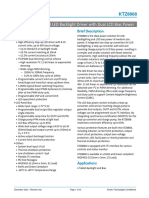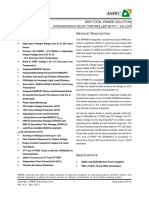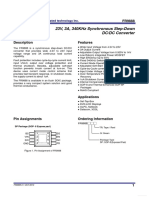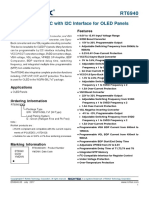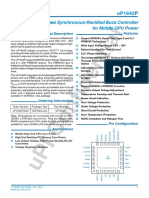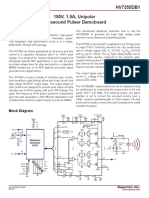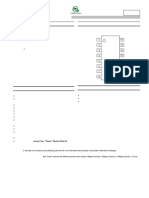DS8510 07
DS8510 07
Uploaded by
CALICopyright:
Available Formats
DS8510 07
DS8510 07
Uploaded by
CALIOriginal Title
Copyright
Available Formats
Share this document
Did you find this document useful?
Is this content inappropriate?
Copyright:
Available Formats
DS8510 07
DS8510 07
Uploaded by
CALICopyright:
Available Formats
®
RT8510
43V 4-CH LED Driver
General Description Features
The RT8510 is a high efficiency driver for white LEDs. It is Wide Input Voltage : 4.2V to 24V
designed for LCD panels that employ an array of LEDs as High Output Voltage : Up to 43V
the lighting source. An integrated switch current mode Adjustable Channel Current : 10mA to 40mA
boost controller drives four strings in parallel and supports Channel Current Accuracy : ±3%
up to 12 pieces of LED per string. The internal current Channel Current Matching : ±2%
sinks support a maximum of ±2% current mismatching PWM Dimming Frequency : 120Hz to 30kHz
for excellent brightness uniformity in each string of LED. Adjustable Switching Frequency : 500kHz to 2MHz
To provide enough headroom for current sink operation Built-In Soft-Start
the boost controller monitors the minimum voltage of Disconnects LED in Shutdown
feedback pins and regulates an optimized output voltage Open Current Sink Detection
for power efficiency. Adjustable Over Voltage Protection
Over Temperature Protection
The RT8510 has a wide input voltage range from 4.2V to
Current Limit Protection
24V and provide an adjustable 10mA to 40mA LED current.
Thin 16-Lead WQFN Package
The internal 200mΩ, 43V power switch with current-mode
RoHS Compliant and Halogen Free
control provides cycle-by-cycle over current protection.
The RT8510 also integrates PWM dimming function for
accurate LED current control. The input PWM dimming
Applications
frequency can operate from 120Hz to 30kHz without UMPC and Notebook Computer Backlight
inducing any inrush current through the LED or inductor. GPS, Portable DVD Backlight
The switching frequency of the RT8510 is adjustable from
500kHz to 2MHz, allowing the user flexibility between Pin Configuration
efficiency and component size. (TOP VIEW)
CH4
CH3
CH2
CH1
The RT8510 is available in a WQFN-16L 3x3 package.
16 15 14 13
AGND 1 12 OVP
Ordering Information COMP 2 11 PGND
GND
RT8510 ISET 3 10 PGND
17
Package Type RT 4 9 LX
5 6 7 8
QW : WQFN-16L 3x3 (W-Type)
PWM
EN
VIN
LX
Lead Plating System
G : Green (Halogen Free and Pb Free)
Z : ECO (Ecological Element with WQFN-16L 3x3
Halogen Free and Pb free)
Note :
Richtek products are :
RoHS compliant and compatible with the current require-
ments of IPC/JEDEC J-STD-020.
Suitable for use in SnPb or Pb-free soldering processes.
Copyright © 2021 Richtek Technology Corporation. All rights reserved. is a registered trademark of Richtek Technology Corporation.
DS8510-07 December 2021 www.richtek.com
1
RT8510
Marking Information
HU= : Product Code
YMDNN : Date Code
HU=YM
DNN
Typical Application Circuit
VOUT
L 43V MAX
VIN 10µH D1
4.2V to 24V
CIN R2
10µF 10 RT8510 ROVP2
7 VIN : : : :
LX 8, 9 2M : : : : 10 LED String
C2 : : : :
1µF COUT
12 : : : :
Chip Enable OVP 10µF
6 EN
ROVP1
100k 62k
PWM Dimming 5 PWM CH1 13
2 14
COMP CH2
R3 4
RT CH3 15
C4
1nF
10k 3 ISET CH4 16
RRT
C3 51k PGND AGND
10nF RISET
4.75k 10, 11 1
Figure 1. General Application Circuit
VOUT
23V MAX
L (VOUT depends on DMAX)
VBATT 10µH D1
2.7V to 24V CIN
10µF
RT8510 ROVP2
7 VIN : : : :
5V LX 8, 9 2M
COUT : : : : 10 LED String
C2 : : : :
1µF 12 10µF : : : :
Chip Enable OVP
6 EN
ROVP1
100k 62k
PWM Dimming 5 PWM CH1 13
2 14
COMP CH2
R3 4
RT CH3 15
C4
1nF
10k 3 ISET CH4 16
RRT
C3 51k PGND AGND
10nF RISET
4.75k 10, 11 1
Figure 2. Low Input Voltage Application Circuit
Copyright © 2021 Richtek Technology Corporation. All rights reserved. is a registered trademark of Richtek Technology Corporation.
www.richtek.com DS8510-07 December 2021
2
RT8510
Functional Pin Description
Pin No. Pin Name Pin Function
1 AGND Analog ground of LED driver.
Compensation pin for error amplifier. Connect a compensation network to
2 COMP
ground.
LED current set pin. LED current is set by the value of the resistor RISET
connected from the ISET pin to ground. Do not short the ISET pin. VISET is
typically 0.6V.
3 ISET
95
ILED =
RISET
Frequency adjust pin. This pin allows setting the switching frequency with a
4 RT
resistor to 500kHz to 2MHz.
5 PWM Dimming control input.
Chip enable (Active High). Note that this pin is high impedance. There should be
6 EN
a pull low 100k resistor connected to GND when the control signal is floating.
7 VIN Power supply input.
8, 9 LX Switching pin of boost converter.
10, 11 PGND Power ground of boost converter.
12 OVP Sense input for over voltage protection. The detecting threshold is 1.2V.
13, 14, 15, 16 CH1 to CH 4 Current sink for LED. Leave the pin unconnected, if not used.
The exposed pad must be soldered to a large PCB and connected to GND for
17 (Exposed Pad) GND
maximum power dissipation.
Functional Block Diagram OVP LX EN VIN
+
- 1.2
Regulator
RT OSC S Q
OCP
R Q
OTP
PWM +
PGND
Controller -
+ 0.4V
COMP EA 4
- LED
PWM Detection
CH1
CH2
CH3
CH4
+ + +
:
:
+ 0.6V - - -
-
ISET
AGND
Copyright © 2021 Richtek Technology Corporation. All rights reserved. is a registered trademark of Richtek Technology Corporation.
DS8510-07 December 2021 www.richtek.com
3
RT8510
Absolute Maximum Ratings (Note 1)
Supply Input Voltage to GND ------------------------------------------------------------------------------------------- −0.3V to 26.5V
EN, PWM, ISET, COMP, RT to GND --------------------------------------------------------------------------------- −0.3V to 26.5V
LX, OVP, CH1, CH2, CH3, CH4 to GND ----------------------------------------------------------------------------- −0.3V to 48V
Power Dissipation, PD @ TA = 25°C
WQFN-16L 3x3 ------------------------------------------------------------------------------------------------------------ 1.471W
Package Thermal Resistance (Note 2)
WQFN-16L 3x3, θJA ------------------------------------------------------------------------------------------------------- 68°C/W
WQFN-16L 3x3, θJC ------------------------------------------------------------------------------------------------------ 7.5°C/W
Lead Temperature (Soldering, 10 sec.) ------------------------------------------------------------------------------- 260°C
Junction Temperature ----------------------------------------------------------------------------------------------------- 150°C
Storage Temperature Range -------------------------------------------------------------------------------------------- −65°C to 150°C
ESD Susceptibility (Note 3)
HBM -------------------------------------------------------------------------------------------------------------------------- 2kV
MM ---------------------------------------------------------------------------------------------------------------------------- 200V
Recommended Operating Conditions (Note 4)
Supply Input Voltage, VIN ------------------------------------------------------------------------------------------------ 4.2V to 24V
Junction Temperature Range -------------------------------------------------------------------------------------------- −40°C to 125°C
Ambient Temperature Range -------------------------------------------------------------------------------------------- −40°C to 85°C
Electrical Characteristics
(VIN = 4.5V, TA = 25°C unless otherwise specified)
Parameter Symbol Test Conditions Min Typ Max Unit
VCOMP = 0V, no switching 0.7 1 1.5
VIN Quiescent Current IQ mA
VCOMP = 2V, switching 1.6 2 3
VIN Shutdown Current ISHDN VIN = 4.5V, EN = 0V 0.01 -- 10 A
Rising 2.07 2.3 2.53
VIN Under Voltage Lockout UVLO V
Falling 1.98 2.2 2.42
Control Input
EN Threshold Logic-High VIH 2 -- --
VIN = 4.2V to 24V V
Voltage Logic-Low VIL -- -- 0.8
PWM Threshold Logic-High VIH 1.5
VIN = 4.2V to 24V
Voltage Logic-Low VIL 0.6
PWM Dimming Frequency f PWM 120 -- 30k Hz
EN, PWM Leakage Current ILKG 2 -- 6 A
EN Shutdown Delay tEN RRT = 51k 28 32 36 ms
Boost Converter
RRT = 25k 1.65 1.94 2.23
Switching Frequency fOSC RRT = 51k 0.94 1.1 1.27 MHz
RRT = 102k 0.48 0.57 0.66
Copyright © 2021 Richtek Technology Corporation. All rights reserved. is a registered trademark of Richtek Technology Corporation.
www.richtek.com DS8510-07 December 2021
4
RT8510
Parameter Symbol Test Conditions Min Typ Max Unit
LX On Resistance (N-MOSFET) RDS(ON)_N VIN > 4.5V 0.18 0.25 0.33
Minimum ON Time tMON 59 90 121 ns
Maximum Duty DMAX VCOMP = 2V, switching 85 90 95 %
LX Current Limit ILIM 1.5 2 2.7 A
LED Current Programming
2V > CHx > 0.4V calculating
LED Current Matching ILEDM (I(MAX) I(AVG)) / I(AVG) x 100%, -2 -- 2 %
RISET = 4.75k
2V > CHx > 0.4V calculating
LED Current Accuracy ILEDA (ICH ISET) / ISET x 100%, -3 3 %
RISET = 4.75k
ISET Pin Voltage VISET 0.56 0.6 0.64 V
LED Current ICHx 2V > CHx > 0.4V, RISET = 4.75k 19.4 20 20.6 mA
Fault Protection
OVP Threshold VOVP 1.16 1.2 1.24 V
OVP Fail Threshold VOVPF 33 55 77 mV
Thermal Shutdown Temperature TSD 145 160 175 °C
LED Pin Under Voltage
VLSD No connection 18 60 100 mV
Threshold
Highest LED string voltage,
Regulated VCHx VCHx 0.3 0.4 0.5 V
RISET = 4.75k
Note 1. Stresses beyond those listed “Absolute Maximum Ratings” may cause permanent damage to the device. These are
stress ratings only, and functional operation of the device at these or any other conditions beyond those indicated in
the operational sections of the specifications is not implied. Exposure to absolute maximum rating conditions may
affect device reliability.
Note 2. θJA is measured under natural convection (still air) at TA = 25°C with the component mounted on a high effective-
thermal-conductivity four-layer test board on a JEDEC 51-7 thermal measurement standard. θJC is measured at the
exposed pad of the package.
Note 3. Devices are ESD sensitive. Handling precaution is recommended.
Note 4. The device is not guaranteed to function outside its operating conditions.
Note 5. Guaranteed by design; not subject to production testing.
Copyright © 2021 Richtek Technology Corporation. All rights reserved. is a registered trademark of Richtek Technology Corporation.
DS8510-07 December 2021 www.richtek.com
5
RT8510
Typical Operating Characteristics
Efficiency vs. Input Voltage LED Current vs. Input Voltage
100 26
90
24
80
LED Current (mA)
70
Efficiency (%)
22
60
50 20
CH1
40 CH2
18
30 CH3
CH4
20
16
10
10 x 4 LEDs, fOSC = 1MHz fOSC = 1MHz
0 14
4 8 12 16 20 24 4 9 14 19 24
Input Voltage (V) Input Voltage (V)
LED Current vs. Temperature VISET vs. Temperature
26 0.70
24 0.65
LED Current (mA)
22 0.60
VISET (V)
20 0.55
18 0.50
16 0.45
VIN = 12V, fOSC = 1MHz VIN = 12V, fOSC = 1MHz
14 0.40
-50 -25 0 25 50 75 100 125 -50 -25 0 25 50 75 100 125
Temperature (°C) Temperature (°C)
VISET vs. Input Voltage LED Current vs. PWM Duty Cycle
0.8 90
80
0.7 70
LED Current (mA)
60
0.6
VISET (V)
50
PWM = 30kHz
40 PWM = 10kHz
0.5 PWM = 1kHz
30 PWM = 120Hz
0.4 20
10
fOSC = 1MHz 10 x 4 LEDs, fOSC = 1MHz
0.3 0
4 8 12 16 20 24 0 10 20 30 40 50 60 70 80 90 100
Input Voltage (V) Duty Cycle (%)
Copyright © 2021 Richtek Technology Corporation. All rights reserved. is a registered trademark of Richtek Technology Corporation.
www.richtek.com DS8510-07 December 2021
6
RT8510
OVP Threshold vs. Input Voltage Switch Off Current vs. Temperature
1.5 1.5
Switch Off Current (mA)
1.4 1.3
OVP Threshold (V)
1.3 1.1
1.2 0.9
1.1 0.7
fOSC = 1MHz fOSC = 1MHz, VIN = 4.5V
1.0 0.5
4 8 12 16 20 24 -50 -25 0 25 50 75 100 125
Input Voltage (V) Temperature (°C)
Line Transient Response Line Transient Response
VIN VIN
(5V/Div) (2V/Div)
IOUT IOUT
(50mA/Div) (50mA/Div)
VIN = 11V to 14V, fOSC = 1MHz VIN = 4.5V to 5.5V, fOSC = 1MHz
Time (50ms/Div) Time (50ms/Div)
Copyright © 2021 Richtek Technology Corporation. All rights reserved. is a registered trademark of Richtek Technology Corporation.
DS8510-07 December 2021 www.richtek.com
7
RT8510
Application Information
T2 T4
The RT8510 is a general purpose 4-CH LED driver capable T1 T3
of delivering an adjustable 10 to 40mA LED current. The
CLK
IC is a current mode boost converter integrated with a
43V/2A power switch and can cover a wide VIN range from Output of PWM
Comparator
4.2V to 24V. The switching frequency is adjustable by an
PWM
external resistor from 500kHz to 2MHz. The part Pulse
Normal Normal Pulse Normal
integrates built-in soft start, with PWM dimming control; Operation Operation Skipped Operation
moreover, it provides over voltage, over temperature and
Figure 3. Pulse Skip Mode
current limiting protection features.
Setting and Regulation of LED Current
Soft-Start
The LED current can be calculated by the following
The RT8510 equips a built-in soft-start feature to prevent
equation :
high inrush current during start-up. The soft-start function
95
prevents excessive input current and input voltage droop ILED
RISET
during power on state.
where RISET is the resistor between the ISET pin and GND.
Compensation This setting is the reference for the LED current at channel
The control loop can be compensates by adjusting the 1-4 and represents the sensed LED current for each string.
external components connected to the COMP pin. The The DC/DC converter regulates the LED current according
COMP pin is the output of the internal error amplifier. The to RISET.
compensation capacitors, C3 and C4, will adjust the
integrator zero and pole respectively to maintain stability. Power Sequence
Moreover, the resistor, R3, will adjust the frequency LED Driver is without power sequence concern. Figure 4,
integrator gain for fast transient response. Figure 5 and Figure 6 are different power sequences
respectively. There is no concern in the above condition.
Switching Frequency
VIN
The LED driver switching frequency is able to adjusted as
the following equation :
51k VOUT
fOSC (MHz)
RRT
EN
LED Connection 1ms
The RT8510 equips 4-CH LED divers with each channel
PWM
supporting up to 12 LEDs. The LED strings are connected
from the output of the boost converter to pins 13, 14, 15 Power On Mode 1
and 16 respectively. If one of the LED channel is not used, Figure 4
the LED pin should be opened directly.
Light Load Mode
When the input voltage is close to the output voltage,
VOUT ripple will increase. The VOUT should be set at higher
than 1.2 x VIN. If duty pulse is close to minimum on-time
and smaller than 120ns, the duty pulse will be skipped.
Figure 3 shows the timing diagram with skipped pulse.
Copyright © 2021 Richtek Technology Corporation. All rights reserved. is a registered trademark of Richtek Technology Corporation.
www.richtek.com DS8510-07 December 2021
8
RT8510
VIN Over Voltage Protection
The RT8510 integrates over voltage protection (OVP)
VOUT
function. When the voltage at the OVP pin reaches the
threshold voltage, the internal switch will be turned off.
EN The internal switch will be turned on again once the voltage
at OVP pin drops below its threshold voltage.
PWM
The OVP threshold voltage is adjustable and can be
Power Off Mode 1-1 clamped at a certain voltage level and it can be calculated
by the following equation :
VIN
R
VOUT(OVP) VOVP 1 OVP2
ROVP1
VOUT
where VOVP = 1.2V (typ.).
EN ROVP1 and ROVP2 are the resistors in the voltage divider
connected to the OVP pin. If at least one string is in normal
PWM operation, the controller will automatically ignore the open
strings and continue to regulate the current for the strings
Power Off Mode 1-2
in normal operation. It is suggested to use 2MΩ for ROVP2
Figure 5
to reduce loading effect.
Current Limit Protection
VIN The RT8510 can limit the peak current to achieve over
UVLO
current protection. The RT8510 senses the inductor
current during the “ON” period that flows through the LX
VOUT
pin. The duty cycle depends on the current signal and
EN
internal slope compensation in comparison with the error
1ms
signal. The internal switch will be turned off when the
PWM current signal is larger than the internal slope
compensation. In the “OFF” period, the inductor current
Power On Mode 2 will be decreased until the internal switch is turned on by
the oscillator.
VIN
UVLO
Brightness Control
The RT8510 brightness dimming control is determined by
VOUT
the signal on the PWM pin with a suggested PWM
EN frequency range from 120Hz to 30kHz. However, the LED
current cannot be 100% proportional to duty cycle
PWM especially for high frequency and low duty ratio because
of physical limitation caused by inductor rising time. Please
Power On Mode 2
refer to Table 1 and Figure 7.
Figure 6
Copyright © 2021 Richtek Technology Corporation. All rights reserved. is a registered trademark of Richtek Technology Corporation.
DS8510-07 December 2021 www.richtek.com
9
RT8510
Table 1. where VOUT is the maximum output voltage, VIN is the
Dimming Frequency (Hz) Duty (Min.) Duty (Max.) minimum input voltage, fOSC is the operating frequency
120 < f PWM 500 0.2% 100% and IOUT is the total current from all LED strings.
500 < f PWM 1k 0.4% 100%
The boost converter operates in DCM over the entire input
1k < f PWM 2k 0.8% 100%
voltage range when the inductor value is below this value
2k < f PWM 5k 1.5% 100%
L. When inductance greater is than L, the converter
5k < f PWM 10k 3% 100%
operates in CCM at the minimum input voltage and may
10k < fPWM 30k 10% 100%
be discontinuous at higher voltages.
Note : The minimum duty in Table 1 is based on the application
The inductor must be selected with a saturated current
circuit and does not consider the deviation of current linearity.
rating that is greater than the peak current provided by
LED Current vs. PWM Duty Cycle the following equation :
90 VOUT IOUT VIN D T
IPEAK
80 VIN 2L
70
where η is the efficiency of the power converter and T is
LED Current (mA)
60 the operating period.
50 PWM = 30kHz
PWM = 10kHz Diode Selection
40
PWM = 1kHz
30
Schottky diodes are recommended for most applications
PWM = 120Hz
because of their fast recovery time and low forward voltage.
20
The power dissipation, reverse voltage rating and pulsating
10
VIN = 12V, VPWM = 0V to 3V peak current are the important parameters for Schottky
0
diode selection. Make sure that the diode's peak current
0 10 20 30 40 50 60 70 80 90 100
rating exceeds IPEAK and reverse voltage rating exceeds
Duty Cycle (%)
the maximum output voltage.
Figure 7
Output Capacitor Selection
Over Temperature Protection
The input capacitor reduces current spikes from the input
The RT8510 has over temperature protection function to supply and minimizes noise injection to the converter. For
prevent the IC from overheating due to excessive power most applications, a 10μF ceramic capacitor is sufficient.
dissipation. The OTP function will shutdown the IC when A value higher or lower may be used depending on the
junction temperature exceeds 160°C . noise level from the input supply and the input current to
the converter.
Inductor Selection
For lower output voltage ripple, a low ESR ceramic
The value of the inductance L can be approximated by the
capacitor is recommended. The output voltage ripple
following equation, where the transition is from
consists of two components: one is the pulsating output
discontinuous conduction mode (DCM) to continuous
ripple current flowing through the ESR, and the other is
conduction mode (CCM) :
D (1 D)2 VOUT VRIPPLE VRIPPLE_ESR VRIPPLE_C
L
2 fOSC IOUT I V VIN1
IPEAK RESR PEAK AVDD
The duty cycle can be calculated according to the following COUT1 VAVDD f
equation :
V VIN
D OUT
VOUT
Copyright © 2021 Richtek Technology Corporation. All rights reserved. is a registered trademark of Richtek Technology Corporation.
www.richtek.com DS8510-07 December 2021
10
RT8510
Thermal Considerations Layout Considerations
The junction temperature should never exceed the PCB layout is very important for designing switching power
absolute maximum junction temperature TJ(MAX), listed converter circuits. The following layout guides should be
under Absolute Maximum Ratings, to avoid permanent strictly followed for best performance of the RT8510.
damage to the device. The maximum allowable power The power components, L1, D1, CIN, COUT must be
dissipation depends on the thermal resistance of the IC placed as close as possible to reduce current loop. The
package, the PCB layout, the rate of surrounding airflow, PCB trace between power components must be as short
and the difference between the junction and ambient and wide as possible.
temperatures. The maximum power dissipation can be
Place L1 and D1as close as possible to LX pin . The
calculated using the following formula :
trace should be as short and wide as possible.
PD(MAX) = (TJ(MAX) − TA) / θJA
The compensation circuit should be kept away from
where TJ(MAX) is the maximum junction temperature, TA is the power loops and should be shielded with a ground
the ambient temperature, and θJA is the junction-to-ambient trace to prevent any noise coupling. Place the
thermal resistance. compensation components as close as possible to
For continuous operation, the maximum operating junction COMP pin.
temperature indicated under Recommended Operating The exposed pad of the chip should be connected to
Conditions is 125°C. The junction-to-ambient thermal ground plane for thermal consideration.
resistance, θJA, is highly package dependent. For a
WQFN-16L 3x3, the thermal resistance, θJA, is 68°°C/W The compensation circuit
should be kept away from the
on a standard JEDEC 51-7 high effective-thermal- power loops and should be Place the power components
CH4
CH3
CH2
CH1
shielded with a ground trace as close as possible. The
to prevent any noise coupling.
conductivity four-layer test board. The maximum power traces should be wide and
short especially for the high-
16 15 14 13
current loop.
dissipation at TA = 25°C can be calculated as below : GND C3 AGND 1 12 OVP
R3
COMP 2 11 PGND
PD(MAX) = (125°C − 25°C) / (68°C/W) = 1.471W for a ISET 3
GND
10 PGND
WQFN-16L 3x3 package. C4 RT 4 17 9 LX D1 VOUT
5 6 7 8
The maximum power dissipation depends on the operating
EN
VIN
LX
PWM
L1 COUT
R2 CIN
ambient temperature for the fixed TJ(MAX) and the thermal
C2
resistance, θJA. The derating curves in Figure 1 allows
+
the designer to see the effect of rising ambient temperature GND GND
VIN
on the maximum power dissipation. Figure 9. PCB Layout Guide
1.60
Four-Layer PCB
Maximum Power Dissipation (W)
1.40
1.20
1.00
0.80
0.60
0.40
0.20
0.00
0 25 50 75 100 125
Ambient Temperature (°C)
Figure 8. Derating Curve of Maximum Power Dissipation
Copyright © 2021 Richtek Technology Corporation. All rights reserved. is a registered trademark of Richtek Technology Corporation.
DS8510-07 December 2021 www.richtek.com
11
RT8510
Outline Dimension
SEE DETAIL A
D D2
L
1
E E2
1 1
2 2
e b
A DETAIL A
A3 Pin #1 ID and Tie Bar Mark Options
A1
Note : The configuration of the Pin #1 identifier is optional,
but must be located within the zone indicated.
Dimensions In Millimeters Dimensions In Inches
Symbol
Min Max Min Max
A 0.700 0.800 0.028 0.031
A1 0.000 0.050 0.000 0.002
A3 0.175 0.250 0.007 0.010
b 0.180 0.300 0.007 0.012
D 2.950 3.050 0.116 0.120
D2 1.300 1.750 0.051 0.069
E 2.950 3.050 0.116 0.120
E2 1.300 1.750 0.051 0.069
e 0.500 0.020
L 0.350 0.450 0.014 0.018
W-Type 16L QFN 3x3 Package
Richtek Technology Corporation
14F, No. 8, Tai Yuen 1st Street, Chupei City
Hsinchu, Taiwan, R.O.C.
Tel: (8863)5526789
Richtek products are sold by description only. Richtek reserves the right to change the circuitry and/or specifications without notice at any time. Customers should
obtain the latest relevant information and data sheets before placing orders and should verify that such information is current and complete. Richtek cannot
assume responsibility for use of any circuitry other than circuitry entirely embodied in a Richtek product. Information furnished by Richtek is believed to be
accurate and reliable. However, no responsibility is assumed by Richtek or its subsidiaries for its use; nor for any infringements of patents or other rights of third
parties which may result from its use. No license is granted by implication or otherwise under any patent or patent rights of Richtek or its subsidiaries.
www.richtek.com DS8510-07 December 2021
12
You might also like
- UP1586p DatasheetDocument17 pagesUP1586p Datasheetmben osbiNo ratings yet
- Database Specification TemplateDocument14 pagesDatabase Specification TemplateLucian Taranu-TudorNo ratings yet
- Manual Fritz 13Document245 pagesManual Fritz 13Renato Vidotto de SouzaNo ratings yet
- Ds8204a 05Document19 pagesDs8204a 05marcelo Chiu LeonNo ratings yet
- 43V Asynchronous Boost WLED Driver: General Description FeaturesDocument11 pages43V Asynchronous Boost WLED Driver: General Description FeaturesfixfixitNo ratings yet
- Single Synchronous Buck Controller: RT8202L/MDocument19 pagesSingle Synchronous Buck Controller: RT8202L/MDenis DenisovNo ratings yet
- RT8204-DS8204-06 Single Synchronous Buck With LDO ControllerDocument19 pagesRT8204-DS8204-06 Single Synchronous Buck With LDO ControllerMaks ProstNo ratings yet
- RT8577ADocument18 pagesRT8577ASamuel SamTechNo ratings yet
- 8T Rt5768aDocument12 pages8T Rt5768aVISHALNo ratings yet
- uPI Confidential: 3A Ultra Low Dropout Linear RegulatorDocument13 pagesuPI Confidential: 3A Ultra Low Dropout Linear RegulatorLEONNo ratings yet
- Richtek-Tech-RT8549LVGQW C426481Document25 pagesRichtek-Tech-RT8549LVGQW C426481Sakrie ElsimateNo ratings yet
- DatasheetDocument10 pagesDatasheetmartin andres rodriguez rengifoNo ratings yet
- 30V, 1.2A Step-Down High Brightness LED Driver With 5000:1 DimmingDocument18 pages30V, 1.2A Step-Down High Brightness LED Driver With 5000:1 DimmingJaPan LifeNo ratings yet
- Data SheetDocument15 pagesData Sheetzakie wahyuNo ratings yet
- 5N Rt8129aDocument18 pages5N Rt8129asubair achathNo ratings yet
- Single Synchronous Buck Controller: RT8202/A/BDocument18 pagesSingle Synchronous Buck Controller: RT8202/A/BMax ReparNo ratings yet
- KTZ8868 04aDocument40 pagesKTZ8868 04aguptajpcfNo ratings yet
- As15 FDocument28 pagesAs15 FHamza Abbasi AbbasiNo ratings yet
- FR9888 FR9886 RT8296A RT8282 Step Down DC DC Converter Buck Ic Nguon Gan Giong Act 4523 PDFDocument11 pagesFR9888 FR9886 RT8296A RT8282 Step Down DC DC Converter Buck Ic Nguon Gan Giong Act 4523 PDFdinh vinh nguyenNo ratings yet
- RT7296F 0.1Document96 pagesRT7296F 0.1Chiapin LeeNo ratings yet
- 3A, 23V, 340Khz Synchronous Step-Down Converter: General Description FeaturesDocument12 pages3A, 23V, 340Khz Synchronous Step-Down Converter: General Description FeaturesAbdul MuhidNo ratings yet
- 3A, 1Mhz, Synchronous Step-Down Converter: General Description FeaturesDocument12 pages3A, 1Mhz, Synchronous Step-Down Converter: General Description FeatureskiryanoffNo ratings yet
- Richtek RT6150B 33GQW DatasheetDocument13 pagesRichtek RT6150B 33GQW Datasheetagsan.algabh2718No ratings yet
- Ω Ω Ω Ω Ω, 1.3A Power Switch with Programmable Current LimitDocument14 pagesΩ Ω Ω Ω Ω, 1.3A Power Switch with Programmable Current LimitSurendra SharmaNo ratings yet
- RT8125C 6XDocument17 pagesRT8125C 6Xtechgamebr85No ratings yet
- Features Description: Ltm4613 En55022B Compliant 36V, 15V, 8A, Dc/Dc Μmodule RegulatorDocument30 pagesFeatures Description: Ltm4613 En55022B Compliant 36V, 15V, 8A, Dc/Dc Μmodule RegulatorSergio GuimarãesNo ratings yet
- DS8468-00 LED Board FoxconnDocument14 pagesDS8468-00 LED Board Foxconndd1663No ratings yet
- Ds8295a 04Document14 pagesDs8295a 04Bsm GwapuNo ratings yet
- RT9088ADocument11 pagesRT9088AБахтиёр БехбудовNo ratings yet
- 2A, 23V, 340Khz Synchronous Step-Down Converter: General Description FeaturesDocument14 pages2A, 23V, 340Khz Synchronous Step-Down Converter: General Description FeaturesGioVoTamNo ratings yet
- Dual-Phase PWM Controller With PWM-VID Reference: General Description FeaturesDocument21 pagesDual-Phase PWM Controller With PWM-VID Reference: General Description FeaturesДмитрий НичипоровичNo ratings yet
- Rt8816a-06 Gtx1070 Gigabyte MemoriasDocument21 pagesRt8816a-06 Gtx1070 Gigabyte Memoriastechgamebr85No ratings yet
- DS8816ADocument21 pagesDS8816AAgustin AyalaNo ratings yet
- RT6940Document45 pagesRT6940Jm TechNo ratings yet
- tdf8530 SdsDocument41 pagestdf8530 SdsOleg OlegFVNo ratings yet
- Innotech Inn8186 Highly Integrated LNB Supply and Control Voltage RegulatorDocument12 pagesInnotech Inn8186 Highly Integrated LNB Supply and Control Voltage RegulatorAndres padillaNo ratings yet
- RT9293Document13 pagesRT9293Bijan AmiriNo ratings yet
- FR9886Document12 pagesFR9886abrkNo ratings yet
- 6A, 23V Synchronous Step-Down Converter With 3.3V/5V LDO: RT6256B/CDocument20 pages6A, 23V Synchronous Step-Down Converter With 3.3V/5V LDO: RT6256B/CkiryanoffNo ratings yet
- AP3031Document13 pagesAP3031ALWHBANY Learn TermuxNo ratings yet
- Rt8292a 1720512Document16 pagesRt8292a 1720512tronmk908No ratings yet
- RT8057Document11 pagesRT8057antonio carlos clementino cruzNo ratings yet
- RT8059Document10 pagesRT8059Bijan AmiriNo ratings yet
- SY8286Document8 pagesSY8286ce604No ratings yet
- 2A, 23V, 340Khz Synchronous Step-Down Converter: General Description FeaturesDocument15 pages2A, 23V, 340Khz Synchronous Step-Down Converter: General Description FeaturesRamon BlancoNo ratings yet
- uP1624P uPISemiconductorDocument18 pagesuP1624P uPISemiconductorSony SanNo ratings yet
- Single Synchronous Buck Controller: RT8209L/MDocument17 pagesSingle Synchronous Buck Controller: RT8209L/MCesar RementizoNo ratings yet
- RT5047 AzamericaDocument16 pagesRT5047 AzamericaSius TécnicaNo ratings yet
- HV7355DB1 150V, 1.5A, Unipolar Ultrasound Pulser Demoboard: General DescriptionDocument9 pagesHV7355DB1 150V, 1.5A, Unipolar Ultrasound Pulser Demoboard: General DescriptionAhmed YasserNo ratings yet
- Datasheet Ic CE DEDocument15 pagesDatasheet Ic CE DEBersama UkhuwahNo ratings yet
- 2A, 23V, 1.2Mhz Synchronous Step-Down Converter: General Description FeaturesDocument14 pages2A, 23V, 1.2Mhz Synchronous Step-Down Converter: General Description FeaturesHaroldo VieiraNo ratings yet
- 1154 FCDocument18 pages1154 FCZekeZer0xNo ratings yet
- RT9624F RichtekDocument13 pagesRT9624F RichtekJouder JimenezNo ratings yet
- uPI Semiconductor Up1735 Synchronous-Rectified Buck Converter DatasheetDocument13 pagesuPI Semiconductor Up1735 Synchronous-Rectified Buck Converter DatasheetSultan SinghNo ratings yet
- 2A, 2Mhz, Synchronous Step-Down Regulator: General Description FeaturesDocument15 pages2A, 2Mhz, Synchronous Step-Down Regulator: General Description FeaturesPedrolaura BethencourtNo ratings yet
- OsciladorDocument14 pagesOsciladorEmmanuel ZambranoNo ratings yet
- DS9030 05Document10 pagesDS9030 05Jois LanzaNo ratings yet
- AL3066 DiodesDocument14 pagesAL3066 Diodesivan ivanovNo ratings yet
- Data SheetDocument28 pagesData SheetCarlos CxsNo ratings yet
- Reference Guide To Useful Electronic Circuits And Circuit Design Techniques - Part 2From EverandReference Guide To Useful Electronic Circuits And Circuit Design Techniques - Part 2No ratings yet
- Reference Guide To Useful Electronic Circuits And Circuit Design Techniques - Part 1From EverandReference Guide To Useful Electronic Circuits And Circuit Design Techniques - Part 1Rating: 2.5 out of 5 stars2.5/5 (3)
- Statistics Module 9 12 VleDocument11 pagesStatistics Module 9 12 VleAlaiza LucasNo ratings yet
- Pb5a 2ansDocument20 pagesPb5a 2ansDevika Sharma100% (1)
- Lesson 5 and 6 - Elasticity of Supply and DemandDocument18 pagesLesson 5 and 6 - Elasticity of Supply and DemandCharles Corporal ReyesNo ratings yet
- CVEN4308 Structural Dynamics: School of Civil and Environmental EngineeringDocument10 pagesCVEN4308 Structural Dynamics: School of Civil and Environmental Engineeringmohamed ahmedNo ratings yet
- En 1051-1Document13 pagesEn 1051-1Hasan OzturkNo ratings yet
- Physics Optics WorksheetDocument5 pagesPhysics Optics WorksheetJasper JamirNo ratings yet
- Excel Charts Visualization Secrets EbookDocument24 pagesExcel Charts Visualization Secrets Ebooksumit mitraNo ratings yet
- Standard Test Methods CFFADocument43 pagesStandard Test Methods CFFAAmparo Mejia RuizNo ratings yet
- Electroheat MKVPlus Pool Heat Pump - Manual - ENG - Oct21 - W99341 F - 1Document18 pagesElectroheat MKVPlus Pool Heat Pump - Manual - ENG - Oct21 - W99341 F - 1joelNo ratings yet
- Discrete Maths TutoriaDocument2 pagesDiscrete Maths Tutoriajiophone10987No ratings yet
- Excel 2016 Charts and GraphsDocument38 pagesExcel 2016 Charts and GraphsHattari AyoubNo ratings yet
- Wireless Power DERIVATION OF AN 'INVERSE LI ENARD-WIECHERT EFFECT' FROM THE LORENTZ FORCE AND ITS APPLICATION TO THE WIRELESS POWER TRANSFERDocument10 pagesWireless Power DERIVATION OF AN 'INVERSE LI ENARD-WIECHERT EFFECT' FROM THE LORENTZ FORCE AND ITS APPLICATION TO THE WIRELESS POWER TRANSFERRobertFBishopNo ratings yet
- Circular MeasureDocument15 pagesCircular MeasureJoann Ng50% (2)
- Roch Mmids Intro 5exercisesDocument9 pagesRoch Mmids Intro 5exercisesaslamzohaibNo ratings yet
- Class 11 Limits 2022Document18 pagesClass 11 Limits 2022warriorNo ratings yet
- Grundfosliterature 5235400Document98 pagesGrundfosliterature 5235400Leopoldo PerezNo ratings yet
- Shell Thickness Calculation ..: MAWP Design PressureDocument6 pagesShell Thickness Calculation ..: MAWP Design PressureSatish ShindeNo ratings yet
- Geographic Information System - NotesDocument18 pagesGeographic Information System - Notes36-Rumaisa RaviNo ratings yet
- First Term Examination Mathematics JSS 1 JSS 2 JSS 3 Exam Questions - ClassRoomNotesDocument8 pagesFirst Term Examination Mathematics JSS 1 JSS 2 JSS 3 Exam Questions - ClassRoomNotesmerisonconceptNo ratings yet
- PNC QuestionsDocument5 pagesPNC QuestionsParthMaluNo ratings yet
- Chapter 6 - Allocating ResourcesDocument60 pagesChapter 6 - Allocating ResourcesAbdur RashidNo ratings yet
- Moisture Density Relation (Compaction) TestDocument5 pagesMoisture Density Relation (Compaction) TestshowravNo ratings yet
- AspenProcessExplorer V73 CP5 NotesDocument5 pagesAspenProcessExplorer V73 CP5 NotessybaritzNo ratings yet
- Ex 3Document3 pagesEx 3danieldemelashalemNo ratings yet
- Aerator Gallery SpillwayDocument13 pagesAerator Gallery SpillwaytonykebbeNo ratings yet
- Hacking CD/DVD/Blu-ray For Biosensing: Edwin En-Te Hwu and Anja BoisenDocument11 pagesHacking CD/DVD/Blu-ray For Biosensing: Edwin En-Te Hwu and Anja BoisenНикита ДолматовNo ratings yet
- OAF Personalizations PDFDocument33 pagesOAF Personalizations PDFBalaji ShindeNo ratings yet
- Fast Return and Interfreq MLBDocument5 pagesFast Return and Interfreq MLBBagoes SidhartaNo ratings yet
















